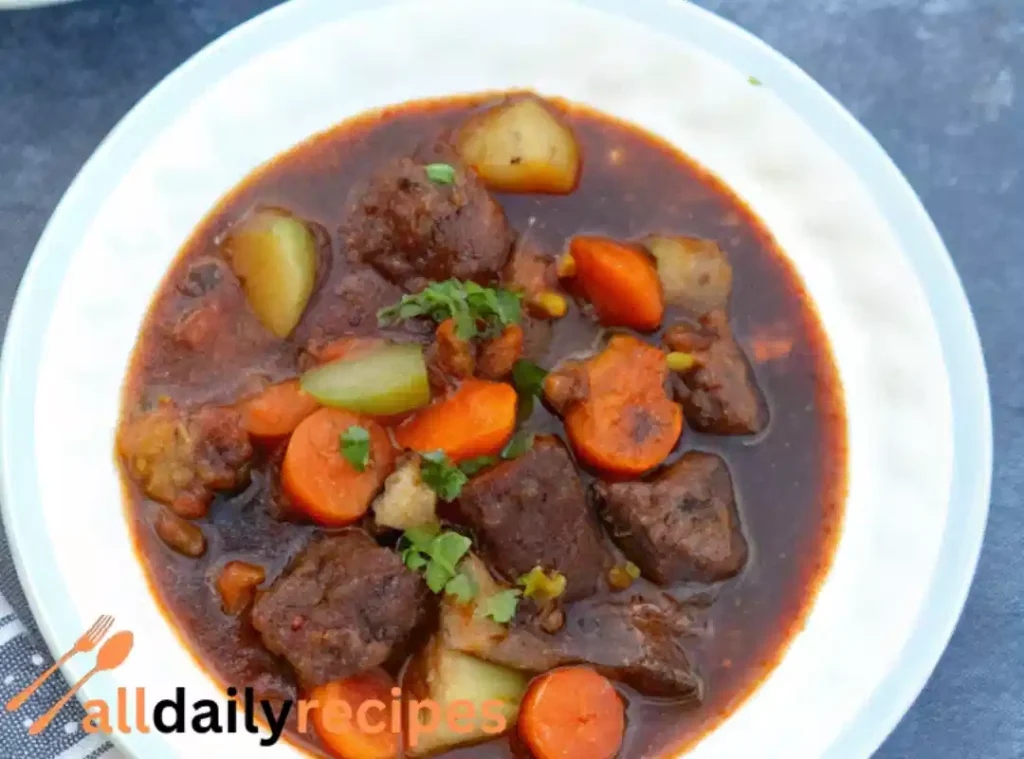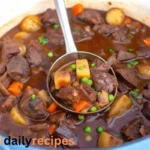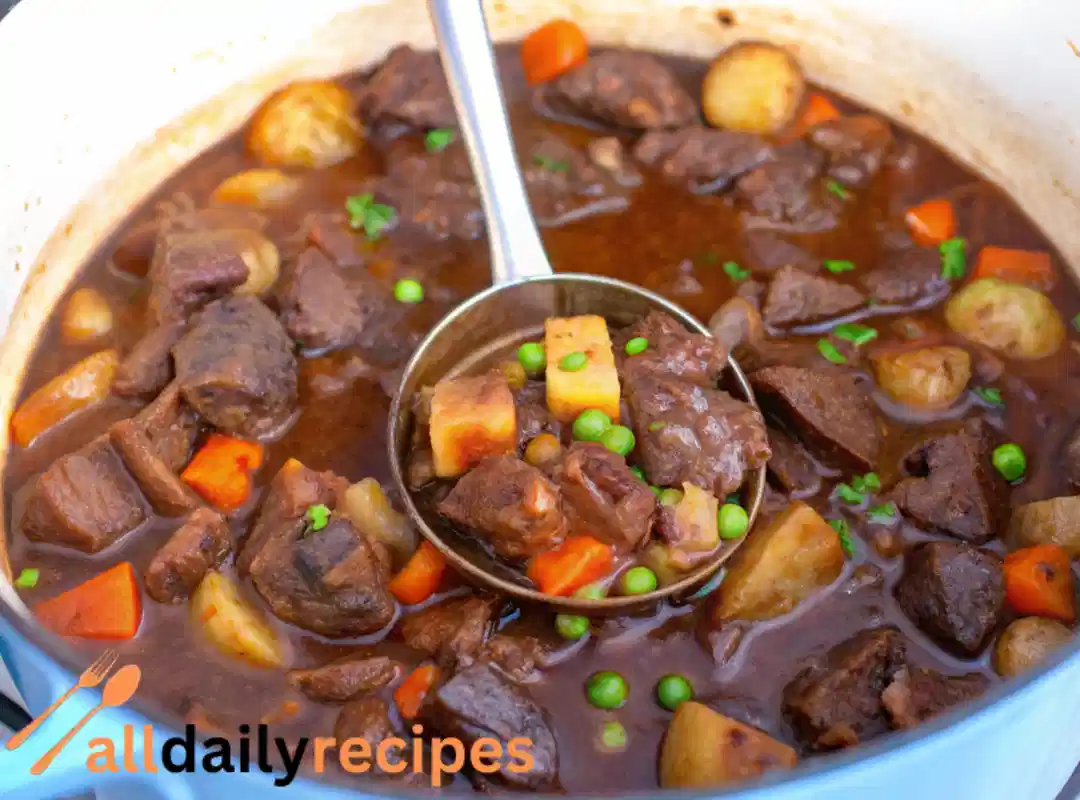When the air turns crisp and your home craves the kind of aroma that makes everyone peek into the kitchen that’s when this stovetop beef stew earns its keep. It’s rich, savory, and surprisingly simple. Just one pot, a little patience, and the kind of ingredients you probably already trust in your kitchen.
This isn’t one of those “reinvented” stews with fancy techniques or trendy shortcuts. Nope. This is the kind of honest, halal-friendly comfort food that takes you back even if you’ve never made it before. Think tender beef, soft potatoes, sweet carrots, and a thick, deeply seasoned sauce that clings to every bite.
What sets this version apart? It’s built for flavor without compromise no floury shortcuts. Just clean, layered seasoning, slow simmering, and a few tricks to pull out the natural depth of ingredients you already know.
In this guide, you’ll get:
- A stovetop method that’s easy and hands-off after the first steps.
- Smart seasoning techniques that deliver full flavor no broth cubes needed.
- Substitution tips, storage advice, and even freezer instructions.
Let’s be honest: you’re not just making dinner. You’re making warmth in a bowl.
Table of Contents
Ingredients
- 2 lbs halal beef chuck, cubed
Chuck roast has just the right balance of lean meat and connective tissue, which breaks down beautifully over a long simmer. Choose fresh, halal-certified beef this stew is built around it. - 1 large yellow onion, diced
It’s the aromatic backbone. Once softened, it melts into the sauce and lays the foundation for flavor. - 2 medium carrots, thick-sliced
These bring natural sweetness and texture. They hold up well to long cooking. - 2 ribs celery, chopped
Adds an earthy, slightly peppery layer that rounds out the broth. - 1 lb red or gold potatoes, cubed
Waxy potatoes are best they don’t break down as easily. They absorb the flavor while holding their shape. - 1 cup frozen peas
Tossed in at the very end, they add a soft pop of sweetness and a burst of color. - 3 tablespoons tomato paste
Thickens the sauce, deepens the color, and adds umami all without any additives or questionable ingredients.
Natural Spice Blend
This combination replaces store-bought seasoning packets or broth cubes nothing artificial, just clean pantry spices:
- 1½ teaspoons sea salt
- 1 teaspoon paprika
- 1 teaspoon dried thyme
- 1 teaspoon dried rosemary
- 1 teaspoon dried marjoram or oregano
- ½ teaspoon ground black pepper
These herbs and spices work together to deliver deep, balanced flavor layered throughout the stew for richness that develops over time.
Other Essentials
- 2–3 tablespoons neutral oil (sunflower, avocado, or light olive oil)
Used for browning the meat and sautéing the aromatics. Choose a mild oil that won’t compete with the stew’s flavor. - 1 teaspoon minced garlic
Added after the onions to avoid burning garlic gives the stew its warm, savory kick. - 2 cups halal beef or vegetable broth
Look for halal-certified versions with minimal ingredients. If unavailable, use water with extra tomato paste and a pinch of each dried herb to boost the flavor. - 1 bay leaf
Optional but traditional adds a subtle herbal note in the background. - 2 tablespoons cornstarch + ¼ cup water
Whisked together and added at the end to thicken the stew naturally no flour or dairy needed.
Optional Finishing Touches
- ¼ cup chopped fresh parsley
Sprinkled over before serving for freshness and color. - Extra broth or water
Keep some on hand in case your stew reduces more than expected during simmering.
Are all these ingredients safe?
Yes all listed items are naturally halal. Just double-check your broth label if using packaged stock. When in doubt, go for homemade broth or just water + tomato paste + extra seasoning.

How to Make Stovetop Beef Stew (Step by Step)
The secret to a truly great beef stew isn’t a fancy trick it’s patience, layering, and knowing when to let the ingredients speak for themselves. Here’s exactly how to pull it off, one step at a time.
Step 1: Get Everything Preppe
Before the heat goes on, do your chopping and measuring. Cut the beef into bite-sized cubes, dice the onion, chop the carrots and celery, and wash and cube the potatoes. Keep the peas frozen they’ll go in at the end.
Step 2: Mix Your Seasoning Blend
In a small bowl, combine:
- 1½ tsp sea salt
- 1 tsp paprika
- 1 tsp dried thyme
- 1 tsp dried rosemary
- 1 tsp dried marjoram (or oregano)
- ½ tsp black pepper
This blend will be used in layers first on the meat, then in the broth. That’s what gives this stew its slow-cooked depth.
Step 3: Brown the Beef (Don’t Skip This)
- Heat 1–2 tablespoons of oil in a large, heavy-bottomed pot over medium-high heat.
- Pat the beef cubes dry with a paper towel. Sprinkle about half of your spice mix over the beef.
- Add the beef in batches don’t overcrowd the pot. Let it brown deeply on all sides, about 4–5 minutes per batch.
- Remove browned beef and set aside in a bowl. Add more oil if needed for the next batch.
Tip: Browning builds flavor. The dark bits stuck to the bottom? That’s where the magic starts.
Step 4: Sauté the Aromatics
- Reduce the heat to medium.
- Add diced onions and celery to the same pot. Stir and scrape up any browned bits as the vegetables release moisture.
- After 3–4 minutes, add the minced garlic and stir for 30 seconds.
- Stir in 3 tablespoons of tomato paste and let it cook for 1–2 minutes until it darkens slightly.
Step 5: Build the Stew Base
- Return the browned beef (and any juices) to the pot.
- Add 2 cups halal beef or vegetable broth and the rest of your spice blend.
- Toss in a bay leaf if using.
- Stir everything together and bring to a gentle boil.
Once boiling, reduce the heat to low. Cover and simmer for 1½ hours, stirring once or twice. The beef will soften and the flavor will deepen.
Step 6: Add the Vegetables
- After 90 minutes, add the cubed potatoes and sliced carrots.
- Stir, cover again, and simmer for another 30–40 minutes until everything is fork-tender.
Tip: Avoid stirring too often at this stage you want those vegetables to hold their shape.
Step 7: Final Touches Peas, Parsley, and Thickening
- Stir in 1 cup of frozen peas and ¼ cup chopped parsley.
- Mix 2 tablespoons of cornstarch with ¼ cup of cold water in a separate bowl. Pour this slurry into the stew and stir well.
- Let it simmer uncovered for another 5–10 minutes, stirring occasionally, until the sauce thickens to your liking.
Remove the bay leaf before serving.
Can I skip the thickener?
Yes the potatoes will naturally add some body. But if you like a rich, spoon-coating texture, the cornstarch slurry makes a big difference. It’s a simple, halal-friendly way to finish the dish strong.
Variations & Customizations
One of the best things about a classic beef stew? It’s endlessly flexible. Whether you’re cooking for dietary needs, regional tastes, or just using up what’s in the fridge, there are plenty of ways to make this dish your own without compromising its halal integrity or comforting flavor.
Make It Without Cornstarch
Prefer to skip the cornstarch? No problem.
- Thickening Option 1: Let the stew simmer uncovered for the last 15–20 minutes. Natural evaporation will reduce and thicken the broth.
- Option 2: Mash a few pieces of potato directly into the stew. It’s an old-school method that works beautifully.
Add More Vegetables
Want to bulk it up or stretch it for more servings?
- Great add-ins:
- Mushrooms (add with onions)
- Turnips or rutabaga (add with carrots)
- Chopped spinach or kale (add near the end)
- Green beans or corn (toss in with the peas)
Tip: Stick to firm vegetables that won’t dissolve during long cooking.
Adjust the Spices to Fit Your Style
The base recipe is warmly seasoned but not spicy. You can easily tweak it for different flavor profiles:
- For a North African feel: Add ½ tsp ground coriander and a pinch of cinnamon or turmeric.
- For a gentle kick: A pinch of chili flakes or a sliced green chili does the trick.
- For earthy depth: Stir in ½ tsp ground cumin with the onions.
Always taste as you go a small addition can shift the stew’s personality in a good way.
Swap the Protein
No beef? No issue just keep the cuts halal and suited for slow cooking:
- lamb shoulder: Richer, slightly gamier, excellent for stew.
- chicken thighs: Not traditional, but works well for a lighter version. Reduce simmer time to avoid overcooking.
- Plant-based option: Try hearty lentils, chickpeas, and mushrooms with the same spice mix for a vegetarian alternative.
Adjust for Lighter Eating
Looking for a leaner or lower-carb version?
- Use lean halal beef or trim visible fat before browning.
- Add extra carrots, celery, and greens while reducing potatoes.
- Use a lighter broth and skip thickening it’ll still be flavorful.
Can I make this stew spicy
Absolutely. Add your preferred spice ground chili, cayenne, or a minced chili pepper early in the cooking process to let it mellow and blend. Start small; stew concentrates flavors over time.
Pro Tips & Common Mistakes When Making Beef Stew
A good beef stew seems simple and it is but there’s a fine line between rich and bland, tender and mushy. Here are the tips that make the difference, plus a few common pitfalls to avoid (because we’ve all been there).
DO: Brown the Beef in Batches
It’s tempting to throw all the meat in at once especially if you’re short on time. But overcrowding causes the beef to steam instead of sear.
- Why it matters: Browning builds flavor and color. Those deep, caramelized edges = richness.
- Fix: Work in batches, let space between pieces, and don’t move the beef too early wait until it naturally releases.
DO: Add Spices in Layers
Sprinkling all your seasoning at once sounds efficient but it misses out on complexity.
- Best approach: Season the beef before browning, then add the remaining spices to the broth later. This creates deeper, more rounded flavor.
DO: Simmer Gently, Not Rapidly
Beef stew needs a low, consistent simmer. A rolling boil can toughen the meat and make the potatoes fall apart.
- Tip: After bringing it to a boil, lower the heat and let it barely bubble. If in doubt, lower the flame and add a splash of broth or water to control the temperature.
DON’T: Stir Constantly
This isn’t a stir-fry. Once everything’s in the pot, trust the process.
- Why not? Over-stirring can break down the vegetables, especially potatoes and carrots. Stir gently every 20–30 minutes, just to check for sticking.
DON’T: Skip the Final Taste Test
Even with perfect ingredients, the flavor can shift after simmering. The last 5 minutes are your chance to adjust.
- What to look for:
- Does it need a pinch more salt or pepper?
- Want more warmth? Add paprika or black pepper.
- Need freshness? A squeeze of lemon juice or more chopped parsley at the end can wake it up.
DON’T: Add Peas Too Earl
Peas only need a few minutes toss them in at the very end.
- Too early? You’ll get dull color and mushy texture.
- Right timing: After thickening the sauce, let them warm through just before serving.
What if my stew is too thin or too thick?
- Too thin? Simmer uncovered for 10–15 minutes to reduce the liquid. Or stir in an extra teaspoon of cornstarch mixed with water.
- Too thick? Add a splash of hot broth or water and stir gently.
How to Store, Freeze, and Reheat Beef Stew (Without Losing Flavor or Texture)
One of the quiet joys of making beef stew? Knowing tomorrow’s leftovers might taste even better than today’s. Here’s how to store, freeze, and reheat it the right way so every bowl still hits warm, rich, and comforting.
Storage (Fridge)
- Let it cool fully: Don’t rush it into the fridge hot. Let the pot sit out (covered loosely) until room temp.
- Use airtight containers: Store in glass or BPA-free plastic, in portions if possible.
- Shelf life: Up to 4 days in the fridge. Beyond that, the texture of the vegetables starts to fade.
Tip: Always refrigerate within 2 hours to keep it food-safe.
Freezing
Beef stew freezes beautifully just follow a few guidelines to avoid mushy potatoes or flavor loss.
- Let it cool completely first.
- Portion it out: Use freezer-safe containers or resealable bags with extra room for expansion.
- Label with the date: Stew stays fresh for up to 3 months in the freezer.
Want better texture later? Some cooks leave out the peas and potatoes before freezing, then add fresh ones when reheating. Not required, but worth trying if you’re picky about texture.
Reheating
Whether from fridge or freezer, gentle heat is your friend.
From the fridge:
- Reheat on the stovetop over low heat, stirring occasionally.
- Add a few tablespoons of broth or water to loosen it, if needed.
From frozen:
- Thaw overnight in the fridge.
- Reheat in a pot over low heat, covered, until fully warmed through.
- Stir occasionally to avoid sticking or uneven heating.
Important: Don’t refreeze leftovers once reheated. Reheat only what you’ll use.
Can I meal prep this beef stew for the week?
Absolutely. It’s ideal for prepping 2–3 meals ahead. Just portion it with rice, couscous, or fresh bread on the side and keep everything stored separately to avoid sogginess.
How to Serve Your Beef Stew (Best Pairings & Plating Ideas)
So the stew is done thick, aromatic, and bubbling gently on the stove. Now comes the fun part: turning it into a full, satisfying meal. Whether you’re feeding a family or just yourself after a long day, these serving ideas elevate the experience from “bowl of stew” to “comfort on a plate.”
Best Sides for Beef Stew
This stew is rich and hearty, so it pairs best with simple sides that balance or soak up all that sauce.
- Fresh flatbread or khobz
Tear and dip the simplest, most soulful combo. - Steamed white or brown rice
A clean base that lets the stew shine. Great for stretching servings. - Couscous or bulgur wheat
Light and fluffy grains that hold up beautifully under stew. - Mashed potatoes
Go classic and creamy stew poured over mashed potatoes is old-school comfort. - Buttered vermicelli noodles or egg-free pasta
A subtle, neutral option that works well with the savory gravy.
Tip: Avoid salty or heavily seasoned sides. The stew already brings the depth your side should support, not compete.
Garnish & Texture Boosters
- Chopped fresh parsley: Adds freshness and color right before serving.
- Cracked black pepper: For a bit of warmth and edge.
- Lemon zest or a squeeze of fresh lemon (optional): Just a tiny bit can brighten up the whole dish especially if you’ve gone heavier on the root veggies.
Drink Pairings (Halal-Friendly)
- Sparkling water with cucumber slices or mint
- Hot tea (mint, black, or cinnamon)
- Chilled hibiscus or pomegranate juice
- Mild yogurt drink or laban (for cooling contrast if you’ve added spice)
Can I serve this stew for guests or special occasions?
Yes with a little plating effort and warm flatbread on the side, it becomes an inviting, family-style dish. Serve it in a large ceramic or clay dish, garnish with herbs, and let everyone dig in together.
Frequently Asked Questions
Even the simplest recipes raise questions once you’re in the kitchen. Here are answers to the most common ones no fluff, just helpful guidance.
Can I use bone-in meat instead of boneless chunks?
What if I don’t have one of the herbs listed?
Can I make this stew in a pressure cooker or Instant Pot?
Brown the beef using the sauté function.
Add aromatics, tomato paste, and broth.
Cook on high pressure for 30–35 minutes.
Quick release, add vegetables, cook 5–7 minutes more.
Add peas and cornstarch slurry at the end to thicken.
Total time drops to about 45 minutes ideal for busy days.
Is this dish freezer-safe with potatoes?
What if I accidentally over-thickened it?
Conclusion
This stovetop beef stew isn’t just a recipe it’s a ritual. The kind you turn to on slow afternoons, cold evenings, or anytime you need to fill your home with warmth that comes from more than just heat. It’s built with care, halal through and through, and flexible enough to fit whatever ingredients your kitchen gives you.
Whether you followed it to the letter or made it your own halfway through, what matters is this: you made something honest. Something real. And hopefully, something worth sharing with family, with neighbors, or just with yourself at the end of a long day.
If you enjoyed this recipe, let me know how it turned out. I’d love to hear what you added, swapped, or served it with. And if you’re looking for your next cozy meal, try my Hearty Lentil & Vegetable Soup or Slow-Simmered Chicken Tagine next. Until then, keep cooking from the heart and may your table always be full.

Stovetop Beef Stew
Ingredients
Method
- Chop and measure all ingredients: beef, onion, carrots, celery, and potatoes.
- Mix the spice blend in a small bowl.
- Heat oil in a large pot and brown the beef cubes in batches.
- Sauté onions and celery in the same pot, then add garlic and tomato paste.
- Return beef and add broth, remaining spices, and bay leaf.
- Bring to a boil, then reduce heat and simmer for 1.5 hours.
- Add potatoes and carrots, cover and simmer for another 30-40 minutes.
- Mix cornstarch with water and add to stew to thicken. Stir in peas and parsley before serving.


Hi there, You have done a great job. I will definitely digg it and individually suggest to my friends. I’m confident they will be benefited from this site.